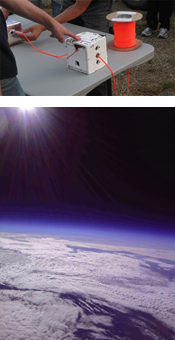
Bottom: Image taken at ~100,000 ft. altitude from the balloon test.
On July 28, 2012, a team of researchers from the Jet Propulsion Laboratory and students from California State Polytechnic University, San Luis Obispo conducted a balloon flight in Windsor, Colorado. Attached to their balloon was a small CubeSat prototype. The CubeSat had four cameras mounted to it and new imaging processing software on-board. The balloon reached an altitude of over 100,000 feet above sea level and was able to acquire over 750 images during the 120-minute balloon flight.
This balloon flight was a technology demonstration for the Intelligent Payload Experiment (IPEX) project. IPEX is a joint mission among JPL, NASA Goddard Space Flight Center, and Cal Poly that is meant to demonstrate autonomous image processing and product generation capabilities onboard satellite instruments. “IPEX is an exciting demonstration of how future missions can be more efficient, do more with less, [and] obtain more relevant data with less relative bandwidth, less turnaround time, and less operational overhead,” says Josh Doubleday, IPEX Autonomy Software Lead at JPL.
As new satellites are able to collect increasingly large amounts of data, current downlink stations will be unable to handle the terabits of data that could stream down to them. Therefore, new technologies that integrate hardware and software are being developed so that satellites can, on their own:
- Acquire an image
- Process the image to detect events or science phenomena (e.g. flooding, wildfires, volcanic activity)
- Produce analyses such as measurement of thermal output, map out the extent of the fire, or determine the extent of the flooding, based on the detections
- Send products and/or images to the ground according to rules defined by a science team
Under this system, images that rise to a set level of significance will still show up rapidly to users (e.g. “rush priority”), and the rest of the data will make its way back to the ground as downlinks allow.
The first part of IPEX is the JPL-developed Continuous Activity Scheduling Planning Execution and Replanning (CASPER), the software that controls the activities of the spacecraft. CASPER plans out the acquisition, processing, and downlink of images. It controls the onboard execution of image analysis software that determines the importance of images based on content. This image analysis software may segment an image into regions, analyze the distribution of pixels, or look for certain signatures or profiles to determine if there is a volcano eruption, a flood, or a forest fire. During the two-hour balloon flight CASPER executed over 300 activities corresponding to over 3000 commands.
Though not tested in this balloon flight, the second part of IPEX is the SpaceCube (SC) Mini, an advanced flight-computing package being developed by NASA Goddard. The SpaceCube Mini includes two Power PC processors and Field Programmable Gate Arrays (FPGAs) to assist in on-board image processing.

The final part of IPEX is the spacecraft bus system designed and built by Cal Poly. This bus includes a computer processor as well as communications, power, telemetry, and structure. The team that is developing this bus is composed primarily of students in the PolySat program, many of whom supported the balloon test flight. “This balloon flight validated prototype hardware and software closely resembling [what] will be used on the final IPEX satellite,” said Cal Poly undergraduate student, Craig Francis. “We got great images, received telemetry beacons from our custom-built UHF communications system, and caught some hardware and software bugs.” The successes and lessons learned from this early balloon demonstration will be applied to the IPEX satellite launch planned for October 2013.
The eventual goal of IPEX is to validate this system to a point where it could be used in future decadal survey and flagship satellite missions, such as for the Intelligent Payload Module (IPM) on the proposed Hyperspectral Infrared Imager (HyspIRI). “IPEX demonstrated the concept of intelligent, autonomous instrument operations of onboard processing and real-time downlink, a key part of the HyspIRI IPM concept,” said Steve Chien, IPEX principal investigator. As missions like HyspIRI could send down terabits of images a day, technology demonstrations like IPEX could help scientists develop systems that will help them sort through data and quickly access data for scientifically significant events.